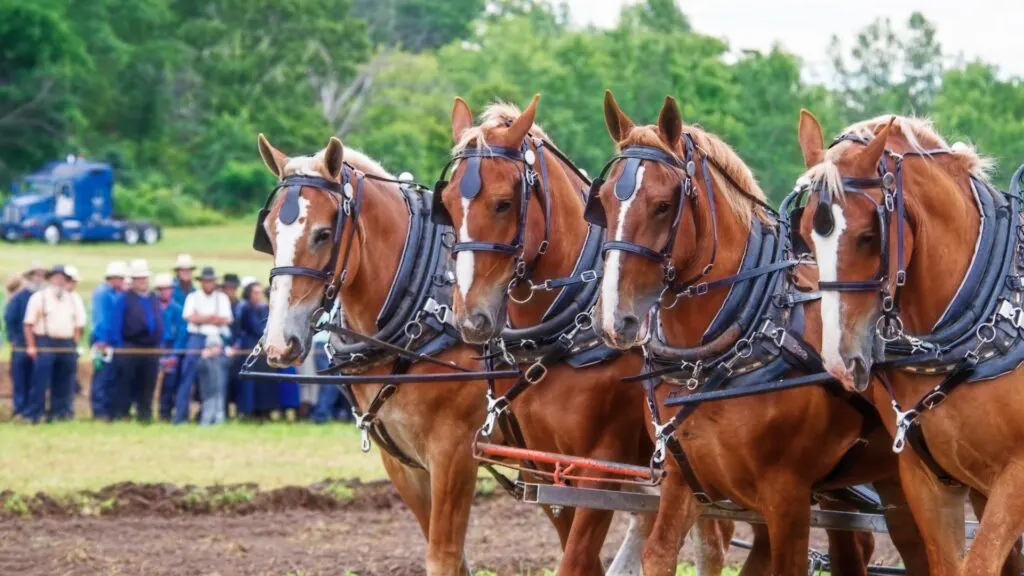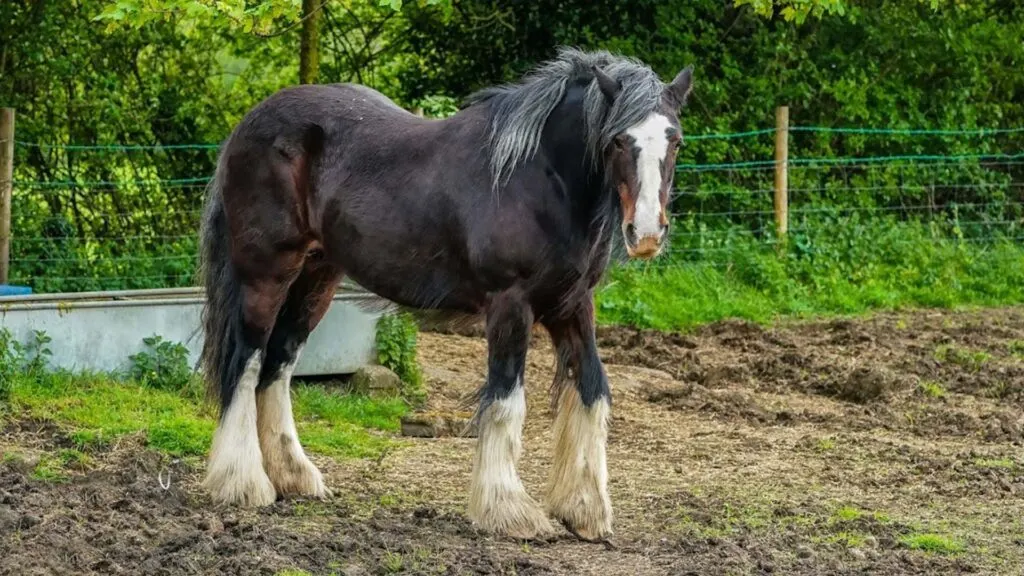Last updated: January 18, 2024
Did you know that the world’s largest horse, a Shire named Sampson, stood an astonishing 21.2 hands high and weighed over 3,000 pounds? Such is the awe-inspiring nature of large horse breeds, animals that combine power and grace in a splendid package.
As an equestrian enthusiast with years of experience and the author of two books on horses, I’ve developed a deep appreciation for large horse breeds. Their sheer size and strength are not just impressive but also tell a story of their historical significance and the roles they’ve played in human civilization.
In this article, we take a journey exploring the world’s largest horse breeds. From the towering Shire to the powerful Belgian Draft, we’ll delve into their histories, characteristics, and the roles they play in our world today. Whether you’re a seasoned horse lover or simply intrigued by big horses, this guide will enhance your appreciation of these extraordinary breeds.

The Largest Horse Breeds in the World
The world’s most impressive and versatile horses tend to be among the largest and are frequently employed for a wide range of purposes, including draft work and showing. Here are the seven biggest horses in the world

Shire Horse
Known as the gentle giants, Shire Horses are historically the world’s largest breed, with roots tracing back to medieval England. They boast a muscular build and calm temperament, now commonly seen in shows and parades.

Belgian Draft Horse
Renowned for their immense strength, Belgian horses are muscular with a broad build. Originally farm horses, they now excel in pulling competitions and recreational riding.
Clydesdale
Clydesdales are famous for their feathered feet and striking appearance. From farm work to starring in commercials, their elegance and strength make them versatile performers.
Percheron
Originating from France, Percherons are known for their intelligence and grey or black coats. Once war horses, they now thrive in driving and therapeutic riding programs.
Suffolk Punch
This sturdy, chestnut-colored breed is one of Britain’s oldest draft horses. With a critical conservation status, efforts are ongoing to preserve this hard-working breed. Interesting fact: The horse breed got its name, “Suffolk Punch,” because of its round appearance.
Irish Draught
They are known for their athleticism and good-natured temperament, making them excellent crosses for sport horses. They’re versatile and used in farming, show jumping, and even police work.
Dutch Draft
One of the heavier draft breeds, originating from the Netherlands, is known for its solid build. Rare but valued for their strength in farming and forestry work.
Here is a bar chart illustrating the average weight of large horse breeds.
The Significance of Large Horse Breeds
Large horse breeds have played a pivotal role in shaping human history and culture. Their significance extends far beyond their impressive size and strength, touching various aspects of human life.
- Historical Backbone: Historically, these breeds were the backbone of agriculture. They were indispensable in plowing fields and hauling heavy loads, contributing significantly to the advancement of farming techniques.
- Transportation Revolution: Before the advent of modern machinery, large horse breeds were the primary means of transportation. They pulled carriages, carts, and even early rail cars, playing a crucial role in the development of trade and travel.
- Cultural Icons: In entertainment, these breeds have been celebrated and revered. From medieval jousting tournaments to modern-day parades and shows, they have always been crowd favorites, symbolizing strength and elegance.
- Warfare and Industry: In times of war, large horses were critical assets used for transporting soldiers and supplies. In peaceful times, they powered industries, moved goods, and powered early industrial machinery.

Caring for Large Horse Breeds
Caring for large horse breeds involves understanding their unique needs and ensuring they receive the right attention for their health and well-being. Here are some key considerations and tips:
- Spacious Living Quarters: Large breeds require ample space, not just in their stables but also in their exercise areas. Ensure their living quarters are spacious enough to accommodate their size comfortably.
- Dietary Management:
- Balanced Nutrition: Their diet should be carefully managed to provide balanced nutrition. This includes high-quality hay or grass, grains, and appropriate supplements.
- Avoid Overfeeding: Due to their size, there’s a tendency to overfeed, but it’s crucial to avoid obesity, which can lead to health issues like laminitis.
- Regular Exercise:
- Consistent Routine: Large horses need regular exercise to maintain their muscle tone and prevent health issues. This can include daily turnout in a paddock and structured exercise routines.
- Gentle Start: For exercise, start gently and gradually increase intensity, considering their large size can put stress on their joints.
- Healthcare Needs:
- Regular Vet Check-ups: Regular veterinary check-ups are essential to monitor their health, including dental care, hoof care, and vaccinations.
- Watch for Joint Issues: Pay special attention to signs of joint stress or arthritis, common in large breeds due to their weight.
- Grooming and Hoof Care:
- Regular Grooming: Due to their size and often thicker coats, regular grooming is essential to maintain skin health and inspect for any issues.
- Hoof Maintenance: Regular hoof care by a professional farrier is crucial, as their large size puts extra pressure on their hooves and legs.
- Special Considerations for Training:
- Patience and Consistency: Training large horse breeds requires patience and consistency. Their size means they might learn and respond differently than smaller breeds.
- Customized Tack: Ensure all tack fits correctly and is comfortable, as ill-fitting equipment can cause sores and discomfort.
To read a well-research study on the differences in equine breeds, check out the study published in Sciencedirect entitled: Horse Personality: Variation between breeds.
Check out the YouTube video below; it provides additional information about the biggest horses in the world.
Common Traits Among the World’s Largest Horses
Each horse is unique, but those with common ancestry often share physical and behavioral traits. This is especially true for large horse breeds.
Key Traits of Large Horse Breeds:
- Impressive Strength: Bred for farm work, these horses are muscular and excel at pulling heavy loads.
- Docile Temperament: Despite their size, they are known for their gentle nature, making them suitable for working with humans.
- Muscular Structure: Their well-defined muscles contribute to their strength and stamina.
- Calm Disposition: Alongside being docile, they are calm and patient, traits that aid in training and handling.
- European Origin: Many originated in Europe and were used historically for farm work, transportation, and military purposes.
- High Energy Levels: They require regular exercise and training to maintain their health and happiness.
- Strong Work Ethic: Bred for labor, these horses have a deep-seated desire to work and please their handlers.
- Versatility: Initially bred for specific tasks, they have adapted to various activities, including riding and driving.
- Longevity: Generally, they have longer lifespans, often living into their late twenties.
- Adaptation to Cold Climates: Many have furry feet, known as feathers, for warmth in cold-weather regions, though this requires careful maintenance to prevent skin irritation.

Here is the table illustrating the average height and weight of large horse breeds:
| Horse Breed | Average Weight/Height |
|---|---|
| The Shire Horse | 2,000 pounds and stands 17 hands tall |
| Belgian Horse breed | 2,000 pounds and stands 16.5 hands |
| Clydesdale Horse breed | 1,900 pounds and stands 17 hands |
| Percheron Horse breed | 1,900 pounds and stands 16.5 hands |
| Suffolk Punch breed | 1,900 pounds and stands 16.5 hands |

Conclusion
We’ve embarked on a fascinating journey through the world of the largest horse breeds, from the majestic Shire to the powerful Belgian Draft. Each breed, with its unique combination of strength, history, and elegance, has played a vital role in shaping our agricultural, transportation, and cultural landscapes.
Caring for these magnificent animals requires dedication and understanding, from their dietary needs to their exercise routines. It’s a rewarding experience that strengthens the bond between these horses and their caretakers.
As living symbols of our shared history, big horse breeds offer endless opportunities for discovery and admiration. I invite you to delve deeper into their world, whether you’re an equestrian enthusiast, a horse caretaker, or simply captivated by their beauty. Continue exploring, learning, and celebrating the extraordinary legacy of these remarkable animals. Join the journey and share in the wonder of these gentle giants.
Additional Resources
For those interested in further exploring the world of large horse breeds, here are some valuable resources to deepen your understanding and knowledge:
- American Shire Horse Association:
- Visit Website
- A comprehensive resource for information on Shire horses, including breed history, care tips, and events.
- Belgian Draft Horse Corporation of America:
- Visit Website
- Offers detailed insights into the Belgian Draft breed, including breeding information and upcoming shows.
- The Clydesdale Horse Society:
- Visit Website
- An authoritative source for all things related to Clydesdale horses, from breed standards to society events.
- Percheron Horse Association of America:
- Visit Website
- Provides extensive information on Percheron horses, including registration details and breeders’ directories.
- The Suffolk Horse Society:
- Visit Website
- A dedicated platform for Suffolk Punch enthusiasts, offering breed information, conservation efforts, and membership options.
- Irish Draught Horse Society:
- Visit Website
- The go-to place for information on Irish Draught horses, featuring breed history, registration, and events.
- The Dutch Draft Horse Association:
- Visit Website
- Offers insights into the Dutch Draft breed, including breed characteristics, history, and preservation efforts.
These resources provide a wealth of information for anyone interested in learning more about these incredible horse breeds. Whether you’re a seasoned horse enthusiast or new to the world of equestrianism, these sites offer valuable knowledge and opportunities to connect with a community of like-minded individuals.
FAQs
What was the biggest horse ever recorded?
The biggest horse ever recorded was a Shire named Sampson (later known as Mammoth), born in 1846 in Bedfordshire, England. He stood an astonishing 21.2 hands high (approximately 7 feet 2.5 inches at the withers) and weighed over 3,300 pounds.
Are large horse breeds suitable for beginners?
Large horse breeds are often known for their calm and gentle temperament, making them suitable for riders of various skill levels, including beginners.
How much does a Belgian Draft Horse typically weigh?
A Belgian Draft Horse typically weighs around 2,000 pounds, showcasing its robust build and muscular physique.
What is the largest horse breed in the world?
The Shire Horse is typically considered the largest horse breed in the world, known for its impressive size and strength.
Can large horse breeds like Clydesdales be used for riding?
Yes, despite their size, many large horse breeds, including Clydesdales, are gentle and can be trained for riding, making them versatile animals.
